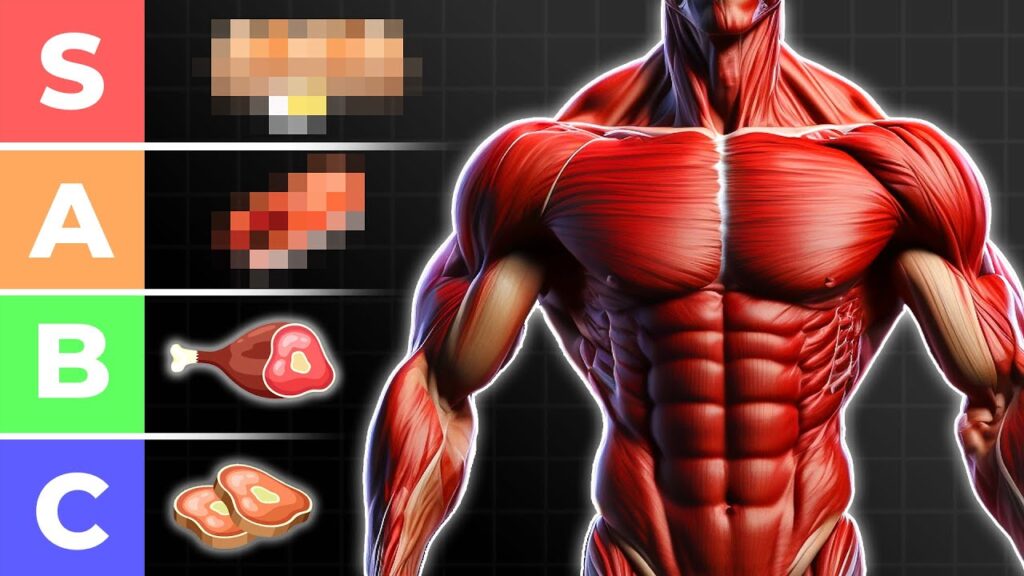In the article “Less optimal choices: processed meats, protein bars, and canned protein sources,” we explore the ranking of different protein foods based on factors such as protein content, bioavailability, nutritional value, accessibility, and cost-effectiveness. We delve into the importance of protein content for muscle protein synthesis and strength gains, as well as the role of bioavailability in how well our body can absorb and utilize protein. Additionally, we consider the nutritional value of protein foods in terms of the vitamins and minerals they provide. We also highlight the accessibility and cost-effectiveness of protein sources to ensure practicality for everyday diets. Throughout the article, we discuss various protein sources and their rankings, from less optimal choices like processed meats and protein bars to reliable options like quinoa, black beans, and cottage cheese. We conclude by highlighting the best protein sources, including eggs, chicken breasts, and whey protein, and emphasizing the importance of incorporating a variety of protein sources in moderation for a balanced and nutritious diet.
Protein Foods and Factors for Ranking
When it comes to protein foods, there are several factors that can affect their ranking and determine their suitability for your diet. In this article, we will explore the importance of protein content, bioavailability, nutritional value, accessibility, and cost-effectiveness when considering different protein sources. By understanding these factors, you can make informed choices about the protein foods you incorporate into your diet.
Protein Content
Protein content is a key factor to consider when ranking protein foods. It refers to the amount of protein present in a particular food source. High-protein foods are essential for muscle protein synthesis and strength gains, particularly when combined with resistance exercise. When looking for protein sources, it is important to consider both the quantity and quality of the protein.
Bioavailability
Bioavailability refers to how well your body can absorb and utilize the protein from a particular food source. Factors such as digestibility, amino acid composition, food matrix and processing, and the presence of other nutrients can all impact bioavailability.
Digestibility is the ease with which proteins can be broken down and absorbed in the digestive system. Some proteins are more easily digested and absorbed than others, making them more bioavailable to the body.
The amino acid composition of a protein is also important. Essential amino acids, which cannot be synthesized by the body and must be obtained from the diet, play a crucial role in protein synthesis. A protein source that contains all nine essential amino acids is considered complete and has higher bioavailability.
The food matrix and processing of a protein source can also impact its bioavailability. The physical form of the food and how it has been processed can affect the protein’s digestibility and absorption.
Lastly, the presence of other nutrients can influence the absorption of proteins. Certain vitamins and minerals can enhance the absorption of proteins, while others may inhibit absorption.
Considering these factors can help you choose protein sources with higher bioavailability, ensuring that your body can effectively utilize the protein you consume.

Nutritional Value
While protein content and bioavailability are important factors, it is also crucial to consider the nutritional value of a protein source. Protein is often accompanied by vitamins and minerals, which contribute to the overall nutritional value of the food.
When choosing protein sources, look for options that provide additional vitamins and minerals. Accompanying vitamins and minerals can contribute to various aspects of your health, such as bone health, immune function, and muscle recovery.
Accessibility and Cost-Effectiveness
Incorporating protein into your diet should also take into account the practicality for everyday use and cost-effectiveness. Protein sources should be readily available and affordable to ensure that you can consistently include them in your meals.
When choosing protein sources based on accessibility and cost-effectiveness, consider options that are easily accessible in your area and fit within your budget. This might include local sources of protein, seasonal options, or cost-effective alternatives.

Less Optimal Choices
While it is important to include protein in your diet, there are some protein sources that are considered less optimal due to various factors. Processed meats, such as sausages and bacon, are rich in protein but also high in saturated fats and sodium, which can negatively impact heart health. Studies link processed meat consumption to serious health issues like heart disease, diabetes, and cancer. It is advisable to limit the intake of processed meats.
Protein bars, while convenient and providing a quick protein hit, often contain added sugars and artificial ingredients that may outweigh their benefits. It is crucial to read labels and choose protein bars with minimal added sugars and natural ingredients.
Canned protein sources, while practical and accessible, often come with added sodium and preservatives, making them less optimal choices compared to fresh or minimally processed alternatives.
Decent but Less Optimal Protein Sources
There are some protein sources that offer decent protein content but may still be considered less optimal due to certain considerations. Peanut butter, for example, is a favorite among athletes, vegetarians, and anyone looking for a quick protein boost. It contains around 7g of protein in just 2 tablespoons. Peanut butter is also rich in healthy fats, specifically monounsaturated and polyunsaturated fats, which contribute to heart health when consumed in moderation. It contains vital nutrients like potassium, magnesium, and zinc, which play crucial roles in muscle recovery, bone health, and immune function.
Milk has been a staple in diets for generations and is known for its balanced nutritional profile. With approximately 8 grams of protein per cup, milk is an excellent source of high-quality protein that supports muscle repair and growth. It is also packed with calcium and vitamin D, two essential nutrients for maintaining strong bones and teeth. Additionally, milk contains phosphorus, B vitamins, and potassium, making it a nutritional powerhouse. However, lactose intolerance can limit access to milk’s benefits for many individuals. Fortunately, lactose-free alternatives and milk from other animal sources or fortified plant-based milk can be good alternatives, offering similar nutritional benefits without the digestive distress.
Tofu, derived from soybeans, is a cornerstone protein source in many vegetarian and vegan diets. It boasts around 10g of protein per half-cup serving. Tofu is a complete protein source, containing all nine essential amino acids. It is also rich in iron, calcium, and magnesium, offering a suite of benefits from improved bone health to muscle function. However, the conversation around tofu also brings to light the topic of bioavailability. While it is a complete protein, the plant-based nature of tofu means its amino acids may not be as readily absorbed by the body as those from animal proteins.

Reliable Options with Impressive Benefits
There are protein sources that offer impressive benefits and can be relied upon for a consistent intake of protein. These options may not be at the very top of the tier list but provide valuable protein content and additional health benefits.
Quinoa, often hailed as a superfood, is a remarkable source of plant-based protein. It packs an impressive 8g of complete protein per cup. Quinoa contains all nine essential amino acids, making it a complete protein source. Studies underscore the role of quinoa in promoting dietary diversity and its positive impact on metabolic health.
Black beans are another nutritional powerhouse, offering a robust 15g of protein per cup. Beyond their protein content, black beans are a rich source of dietary fiber and antioxidants. The fiber found in black beans can help reduce the absorption of cholesterol in the digestive tract, thereby lowering blood cholesterol levels and reducing the risk of heart disease. Additionally, the antioxidants in black beans combat oxidative stress, contributing to overall health and well-being.
Cottage cheese rounds out this trio of reliable options with a substantial 28g of protein per cup. It is not only high in protein but also low in fat, making it an excellent choice for those looking to build muscle without consuming excess calories. Cottage cheese is also an excellent source of calcium, which is essential for bone health. Research highlights the effectiveness of dairy proteins, like those found in cottage cheese, in promoting muscle synthesis and recovery after exercise.
Excellent Protein Sources with Additional Health Benefits
At the top of our protein tier list are protein sources that not only provide high-quality protein but also offer additional health benefits. These sources can be considered excellent choices to incorporate into your diet.
Salmon and tuna are not just any fish in the sea. They are nutritional powerhouses. Beyond their rich protein content, which is fundamental for muscle repair and growth, they are also rich in omega-3 fatty acids. Omega-3s are pivotal in supporting heart health, improving lipid profiles, and enhancing brain function. Regular consumption of these omega-3 rich fish can lower the risk of heart disease, showcasing the power of what’s on your plate to influence your health.
Greek yogurt, which could be considered the heavyweight champion in the dairy aisle, packs nearly double the protein punch of regular yogurt. It is an excellent choice for those looking to build muscle or maintain a healthy protein intake. Dairy protein, like that found in Greek yogurt, can significantly enhance recovery post-exercise and improve muscle synthesis.
Lean beef, often unfairly vilified in discussions about healthy eating, is a nutritional powerhouse. It is an excellent source of high-quality protein, vital for muscle mass and strength. Lean beef is also rich in iron and vitamin B12. Iron is indispensable for transporting oxygen throughout your body, crucial during both high-intensity workouts and day-to-day life. Vitamin B12 plays a key role in nerve function and the production of DNA.
Conclusion
When it comes to protein foods, prioritizing your choices based on factors such as content, bioavailability, nutritional value, accessibility, and cost-effectiveness is essential. Protein content is crucial for muscle protein synthesis and strength gains, while bioavailability determines how well your body can absorb and utilize the protein. Consider the accompanying vitamins and minerals when assessing a protein source’s nutritional value. Additionally, ensure that your protein choices are easily accessible and practical for everyday diets.
While there are some less optimal protein sources, such as processed meats, protein bars, and canned protein sources, there are also decent options like peanut butter, milk, and tofu that provide valuable protein content. For reliable options with impressive benefits, consider incorporating quinoa, black beans, and cottage cheese into your diet. And for excellent protein sources with additional health benefits, look to salmon, tuna, Greek yogurt, and lean beef.
Remember, incorporating a variety of protein sources into your diet in moderation is key to achieving a balanced and nutritious eating pattern. By understanding the factors that determine the ranking of protein foods, you can make informed choices to support your health and fitness goals.
